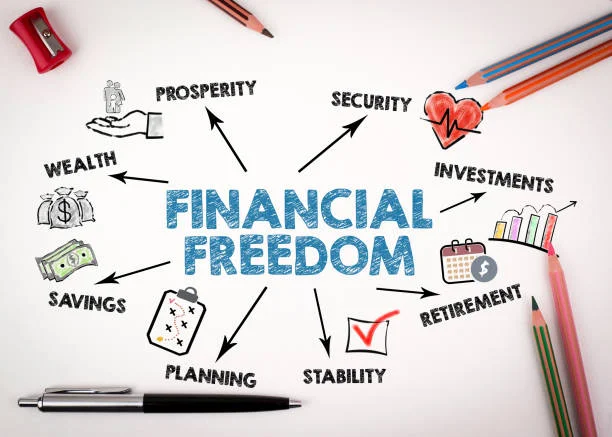Do you feel trapped by a budget that never works? You’re not alone. It’s common to draft a plan on Monday only to abandon it by Friday. To achieve financial freedom, you need a budget that matches your life and a roadmap to your goals. This guide offers financial freedom advice on how to get financial freedom and outlines clear steps to financial freedom.
In this guide, you’ll discover how to get financial freedom by:
•Build a realistic budget that aligns spending with your priorities
•Eliminate debt using proven payoff methods
•Automate savings and create a reliable emergency fund
•Invest for the long term and leverage compound interest
•Grow and diversify your income with side gigs and passive streams
•Cultivate a mindset geared toward lasting habits and SMART goals
•Use technology and community support to stay motivated
By following these steps to financial freedom, you’ll move beyond quick fixes and set up systems that keep you on track. You’ll learn practical financial freedom advice, from zero-based and envelope budgeting to debt snowball vs. avalanche payoffs. You’ll see how small, consistent actions compound into big results that help you achieve financial freedom.
Continue your journey: This related article is worth your time.
Build a Realistic Budget
Creating a budget aligned with your priorities is one of the first steps to financial freedom. Start by tracking all income sources and monthly expenses. Use a budgeting app or a simple spreadsheet to record transactions daily. At the end of each week, review your statements to spot spending trends. Then adjust categories at month end and set targets that reflect your real habits.
Track Income and Expenses
List every income source and categorize fixed and variable costs. Record transactions in real time to avoid surprises. At month end, run a summary to identify areas to cut back and categories to increase. This step shows how to achieve financial freedom by giving you a clear view of cash flow.
Zero-Based and Envelope Budgeting
Zero-Based Budgeting
Zero-based budgeting assigns every dollar to a category until income minus outlays equals zero. This approach forces deliberate choices and highlights waste. Track your allocations each pay period and compare to actual spending to stay on track.
Envelope Budgeting
Envelope budgeting allocates fixed amounts to spending categories in physical or digital envelopes. When an envelope empties, pause spending until the next period. Opt for digital envelopes or physical cash to simplify tracking.
Eliminate and Avoid Debt
Eliminating debt and avoiding new balances is crucial for financial freedom. Use the snowball approach to pay off smaller debts first, which builds motivation. Or choose the avalanche method to tackle high-interest balances and minimize the total interest you pay.
Debt Snowball vs. Avalanche Methods
Debt Snowball
•List debts from smallest to largest by balance
•Pay minimums on all and direct extra funds to the smallest
Debt Avalanche
• Rank debts by interest rate, highest to lowest
• Pay minimums on all and funnel extra toward the highest rate
Responsible Credit Card Use
Maintaining a healthy credit profile helps you avoid new debt and stay financially independent.
Adopt these habits:
• Pay your full statement balance each month to avoid interest
•Keep your credit utilization below 30 percent of your limit
•Avoid cash advances and fees
Automate Savings & Build an Emergency Fund
Automate savings and build an emergency fund to reduce money stress. Set up automatic transfers from your checking account to a dedicated savings account. Aim for three to six months of essential expenses in a liquid, FDIC-insured account. This step moves you closer to being financially independent and gives you freedom from money worries.
Calculating Your Emergency-Fund Goal
Estimate your average monthly living costs, including rent or mortgage, utilities, groceries, insurance, and minimum debt payments. Multiply that by three to six, adjusting based on job security, dependents, and variable income.
Leveraging High-Yield Savings Vehicles
Look for online banks or credit unions with competitive rates. For educators, a teachers credit union often offers favorable rates. High-yield savings and money-market accounts keep funds accessible while earning interest. Consider splitting direct deposit to funnel part of each paycheck directly into your emergency fund. Set balance alerts and calendar reminders to track progress and prevent overdrafts.
Invest for the Long Term
Investing for the long term is a key step to achieve financial freedom. Compounding and consistent contributions can build wealth over decades.
Understanding Compound Interest
Compound interest accelerates growth by earning returns on both contributions and prior gains. The more often interest compounds, the faster your balance grows. As a rule of thumb, use the Rule of 72 to estimate the years needed to double your investment. Divide 72 by your annual return rate to get a rough timeline. Start early and reinvest dividends to harness compounding. Pair compounding with a diversified portfolio to smooth returns.
Choosing the Right Retirement Accounts
Selecting tax-advantaged accounts can boost after-tax gains and protect your earnings from erosion.
401(k) and Employer Match
Employer-sponsored plans often include matching contributions, so aim to contribute at least enough to capture the full match.
IRA vs. Roth IRA
Traditional IRAs offer tax deductions now, while Roth IRAs provide tax-free withdrawals in retirement. Balance your contributions based on your current tax bracket and future outlook.
Grow & Diversify Your Income
Boosting earnings is crucial to becoming financially independent. Pair skill-based side gigs with scalable investments to accelerate your journey to financial freedom.
Side-Hustle Ideas Tied to Your Skills
Tap into existing strengths and market demand:
•Freelance writing or design: Offer project-based services on platforms or directly to clients
•Online tutoring or coaching: Teach subjects or skills over video calls
•Consulting or virtual assistance: Provide expert guidance or administrative support in your field
•Tax preparer: Offer filing and planning services to individuals and small businesses during tax season
Alternative Passive-Income Vehicles
Explore capital-light options that generate ongoing returns:
•Digital products: Create e-books, courses, or stock images to sell on established marketplaces
•Dividend-growth ETFs: Invest in diversified portfolios that pay regular dividends
•Real-estate crowdfunding: Pool funds with other investors to access property income
•Peer-to-peer lending: Earn interest by funding personal loans on reputable platforms
A balance of active and passive streams ensures you maximize earnings now while building automated income that grows over time.
Cultivate a Financial Freedom Mindset
Your mindset shapes every decision on the path to financial freedom. Start by defining financially free. What does financial freedom mean to you? This clarity guides every action. Embrace a growth approach by seeing skills as learnable and viewing setbacks as lessons. Commit to a “save first, then spend” habit to reinforce discipline and build resilience.
Setting SMART Financial Goals
Setting SMART goals is a proven strategy to achieve financial freedom. Break big ambitions into Specific, Measurable, Achievable, Relevant, and Time-bound targets:
• Specific: Define clear savings or debt milestones
•Measurable: Track progress with numbers or dates
• Achievable: Set realistic steps based on income
• Relevant: Align goals with your values and priorities
•Time-bound: Assign deadlines to stay focused
Gamification Techniques to Stay on Track
Turn your journey to financial freedom into a game:
• Use point systems or progress bars to visualize achievements
• Earn badges or micro-incentives for hitting milestones
•Join friendly challenges or leaderboards with peers
•Stack habits by linking saving actions to daily routines
Leverage Technology & Community Support
Fintech platforms and peer accountability boost both budgeting success and motivation.
AI-Driven Finance and Budgeting Apps
As part of financial freedom advice, AI-based tools use machine learning to analyze spending habits, auto-categorize up to 95 percent of transactions, and forecast expenses. Apps like Cleo and Rocket Money can save $80 to $500 yearly by identifying waste, canceling unwanted subscriptions, and recommending optimal transfer amounts. Copilot and Origin’s Sidekick adjust budgets dynamically, offer rollover balances, and sync goals with investment tracking.
Forming or Joining Accountability Groups
Peer groups provide social motivation and structure. Invite friends or coworkers with similar goals. Schedule weekly check-ins via chat or video. Share progress, celebrate wins, and troubleshoot challenges. Public commitment and group feedback build consistency, turning personal finance into collective effort as you work to get financial freedom.
Conclusion
Breaking free from the budget trap is about more than cutting costs, it’s about building systems that adapt to your life and goals. In this guide, you learned the steps to financial freedom:
•Build a realistic budget that aligns spending with your priorities
•Choose and apply the right debt payoff method
•Automate savings to build your safety net
•Invest early to benefit from compound returns
•Expand income through side gigs and passive streams
•Cultivate a growth mindset with SMART goals and gamification
•Leverage apps and community support for ongoing motivation
These steps work together to help you achieve financial freedom. Track your progress and make small adjustments to stay on course. Now pick one action today: start tracking expenses, set up an auto-transfer, or join a peer group. Real freedom from money stress comes from steady habits, not one-time fixes. The groundwork you’ve laid here will carry you forward. Your path to financial freedom starts now. Take the first step and keep moving.
Want more insights like this? Head over to 2A Magazine and start exploring.







